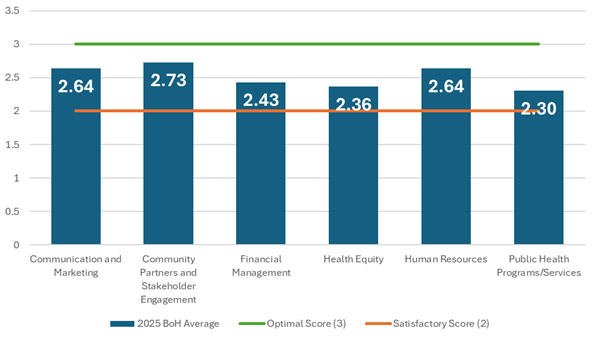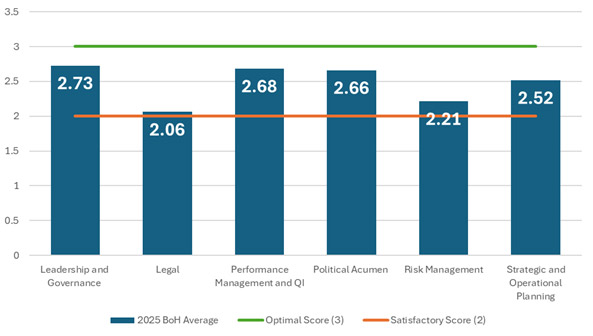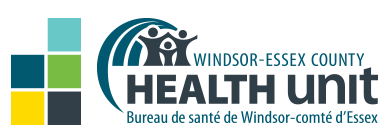Introduction
In March 2025, a competency based self-assessment survey was distributed to WECHU Board of Health (BoH) members. This survey was structured around twelve competency areas and was developed based on the Ontario Public Health Standards (OPHS) (2021), the WECHU BoH By-laws, and the Association of Local Public Health Agencies Board of Health Governance Toolkit. The purpose of this approach was to identify the strengths of the BoH, while also identifying opportunities to provide additional training and support. The OPHS (2021), under the Good Governance and Management Practices Domain, states: “the board of health shall have a self-evaluation process of its governance practices and outcomes that is completed at least every other year. Completion includes an analysis of the results, board of health discussion, and implementation of feasible recommendations for improvement, if any”.
The same survey has been implemented since 2017, allowing for a comparison of the data across years. Current BoH membership includes 13 members, of which 11 completed the 2025 self-evaluation competency survey.
Results
Competency Scores
There were 2 to 4 questions asked for each of the 12 competency areas. Scores for each competency ranged from 0 to 4. The BoH average scores for each statement can be found in Appendix A. The overall BoH average score for each competency, along with the difference from the satisfactory and optimal range, can be found in Table 1.
The satisfactory response range (BoH average scores greater than 2, but below 3) reflects a score indicating that BoH members, on average, have the necessary competencies to successfully complete tasks related to that topic, but might require assistance from an expert at times.
The optimal response range (BoH average scores greater than or equal to 3) represents areas where BoH members on average are able to function most effectively and are able to perform actions related to these topic areas without expert assistance.
| Competency | 2020 BoH Average baseline | 2024 BoH Average | 2025 BoH Average | Difference from 2024 Average | 2025 Difference from satisfactory | 2025 Difference from optimal |
|---|---|---|---|---|---|---|
| Communication and Marketing | 2.67 | 2.33 | 2.64 | ↑0.31 | ↑0.64 | ↓0.36 |
| Community Partners and Stakeholder Engagement | 2.7 | 2.59 | 2.73 | ↑0.14 | ↑0.73 | ↓0.27 |
| Financial Management | 2.6 | 2.52 | 2.43 | ↓0.09 | ↑0.43 | ↓0.57 |
| Health Equity | 2.35 | 1.81 | 2.36 | ↑0.55 | ↑0.36 | ↓0.64 |
|
Human Resources
|
2.65 | 2.54 | 2.64 | ↑0.10 | ↑0.64 | ↓0.36 |
| Knowledge and Delivery of Public Health Programs/Services | 1.87 | 1.79 | 2.30 | ↑0.51 | ↑0.30 | ↓0.70 |
| Leadership and Governance | 3.08 | 2.71 | 2.73 | ↑0.02 | ↑0.73 | ↓0.27 |
| Legal | 2.1 | 1.90 | 2.06 | ↑0.16 | ↑0.06 | ↓0.94 |
| Performance Management and Quality Improvement | 2.65 | 2.42 | 2.68 | ↑0.26 | ↑0.68 | ↓0.32 |
| Political Acumen | 3.02 | 2.35 | 2.66 | ↑0.31 | ↑0.66 | ↓0.34 |
|
Risk Management
|
2.3 | 2.10 | 2.21 | ↑0.11 | ↑0.21 | ↓0.79 |
| Strategic and Operational Planning | 2.43 | 2.38 | 2.52 | ↑0.14 | ↑0.52 | ↓0.48 |
The overall average score for 2025 was 2.50 which was an increase from the 2024 average of 2.29.
As shown in Table 1, average scores in 2025 were higher than those in 2024 for all but one competency: Financial Management
Figures 1 and 2 are visual representations of the BoH average score on each competency compared to the satisfactory (2-2.99) and optimal (3-3.99) range. All the competency scores were above the satisfactory range threshold. No competencies fell into the optimal range.
Figure 1. Average scores compared to the satisfactory and optimal range

Figure 2. Average scores compared to the satisfactory and optimal range (con’t).

Lastly, members were asked if they had any feedback or suggestions for future learning topics. Comments included a request to learn about organizational risk assessments, how to improve services and quality control efficiency using databases, specific infectious disease response mechanism, and our relationship with the Ontario Health team and how they intertwine with other stakeholders/partners.
Overall Recommendations
- Continue to update and offer training sessions and e-learning modules to board members, focusing on those areas with the lowest scores (i.e., Legal, Risk Management).
- Continue to provide quarterly opportunities to Board of Health members to provide feedback and recommendations related to Board of Health strategies and decision-making to ensure continuous quality improvement.
Appendices
| BoH Average | Minimum | Maximum | |
|---|---|---|---|
| Communication and Marketing | |||
| Successfully communicating organizational messages to the media. | 2.64 | 1.00 | 4.00 |
| Representing the interests of an organization in the media. | 2.64 | 1.00 | 4.00 |
| Interacting with partners to promote programs/services. | 2.64 | 2.00 | 3.00 |
| Community Partners and Stakeholder Engagement | |||
| Identifying key partners/stakeholders. | 2.64 | 1.00 | 3.00 |
| Establishing strong partnerships with other organizations. | 2.82 | 2.00 | 4.00 |
| Resolving conflicts between partners/stakeholders. | 2.73 | 2.00 | 4.00 |
| Financial Management | |||
| Assessing financial information. | 2.45 | 2.00 | 3.00 |
| Managing a budget within an organization. | 2.55 | 1.00 | 3.00 |
| Creating innovative approaches to deal with fiscal restraints. | 2.18 | 1.00 | 3.00 |
| Re-allocating resources within an organization. | 2.55 | 1.00 | 4.00 |
| Health Equity | |||
| Identifying barriers individuals face when accessing public health services. | 2.36 | 1.00 | 4.00 |
| Consideration of health inequities in program/services decision making. | 2.36 | 1.00 | 4.00 |
| Human Resources | |||
| Assessing the work-related performance of employees. | 2.73 | 2.00 | 4.00 |
| Attracting and retaining employees. | 2.45 | 1.00 | 3.00 |
| Succession planning in an organization. | 2.64 | 2.00 | 4.00 |
| Addressing challenges in a unionized environment. | 2.73 | 2.00 | 4.00 |
| Knowledge/ Delivery of Public Health Prgms/Services | |||
| Integrating client/customer needs into programs/services. | 2.45 | 1.00 | 4.00 |
| Developing evidence-based programs/services. | 2.36 | 1.00 | 4.00 |
| Implementation of the Ontario Public Health Standards. | 2.09 | 1.00 | 3.00 |
| Leadership and Governance | |||
| Guiding an organization through change to reach their goals. | 2.64 | 2.00 | 4.00 |
| Leadership-level guidance of organizational operations. | 2.64 | 2.00 | 4.00 |
| Service on other boards or committees. | 2.82 | 2.00 | 3.00 |
| Decision-making that considers the impact on relevant stakeholders. | 2.82 | 2.00 | 3.00 |
| Legal Acumen | |||
| Managing organizational legal considerations. | 2.00 | 0.00 | 4.00 |
| Adhering to ministry required Board of Health legal obligations. | 2.18 | 0.00 | 3.00 |
| Applying ministry-level legal requirements in an organization. | 2.00 | 0.00 | 3.00 |
| Performance Mgmt and Quality Improvement | |||
| Supporting an organizational culture of continuous quality improvement. | 2.73 | 2.00 | 4.00 |
| Making organizational decisions based on the quality of programs/services. | 2.64 | 2.00 | 4.00 |
| Political Acumen | |||
| Advocating for the passing and enforcement of healthy public policies. | 2.55 | 1.00 | 4.00 |
| Identifying key players in the political decision-making process. | 2.91 | 1.00 | 4.00 |
| Developing healthy public policies (e.g., analyzing, planning, implementing, and evaluating policy). | 2.55 | 1.00 | 4.00 |
| Understand the formal process for decision making at the municipal level. | 2.64 | 1.00 | 4.00 |
| Risk Management | |||
| Prioritization of risks to determine which should be addressed by an organization. | 2.18 | 1.00 | 3.00 |
| Documenting the cause and consequence(s) of identified organizational risks. | 2.18 | 1.00 | 3.00 |
| Identifying organizational risks. | 2.27 | 1.00 | 3.00 |
| Strategic and Operational Planning | |||
| Working towards organizational strategic priorities. | 2.55 | 2.00 | 3.00 |
| Monitoring progress towards meeting a strategic plan. | 2.45 | 2.00 | 3.00 |
| Development of organizational strategic plans. | 2.55 | 2.00 | 3.00 |

